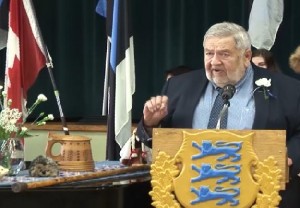The heightened tensions between the NATO allies and Russia have reached Cold War heights as widely claimed. But they seem to decline and ascend as international circumstances dictate. The current NATO/Moscow mutually incriminating face-off will most likely be temporary, as history has shown.
But the Estonia/Russia stand-off seems immutable. No, the Bronze soldier is not a newsworthy item in the on-going unyielding and acrimonious historical dispute between Estonia and Russia. Although it’s been relocated to a military cemetery, far from it’s former place in Tallinn’s centre, the Bronze Soldier still remains lodged as a potent historical symbol for both countries.
Briefly, the statute erected in 1947 by the Soviet occupation regime, ostensibly marked the grave of Red Army soldiers, thus signifying for Moscow and for most Russians in Estonia a memorial for victory over Nazism. It reinforced their Russian identity, for many Russian-speaking Estonian citizens and non-citizen resident. Most had been relocated into Estonia during the occupation, a transgression under the Geneva Convention forbidding occupying powers guiding it’s citizens onto occupied territories.
For Estonians, Red Army soldiers were not liberators. They were totalitarian occupiers making the statue a galling and painful symbol of a half century of cruel Soviet mass deportations, outright assassination, general repression, shortages of everyday goods, etc. The Bronze Soldier was a painful symbol of half a century of Soviet oppression and represented a resumption of Moscow’s earlier occupation of their homeland – a genocidal interlude that had been the result of the squalid pact between Hitler and Stalin in 1939.
The post-war WWII years saw a remorseless strangling of any hope of a revived independence. And still unacceptable to all Estonians is the Kremlin’s relentless insistence that Estonia voluntarily joined the USSR during the first Soviet occupation in 1940.
The resentment that had been mounting beneath the surface of Estonian society, broke out in April 2007 and the government moved the statue to its current location. This was perceived as an outrageous insult by many Russians who rioted and looted the following two nights. The media reaction, local as well as international, generally favoured the government’s actions.
(Pikemalt saab lugeda Eesti Elu 22. oktoobri 2021 paber- ja PDF/digilehest)

The legacy of the Bronze soldier (3)
Eestlased Kanadas | 22 Oct 2021 | Eesti Elu
Viimased kommentaarid
Kommentaarid on kirjutatud EWR lugejate poolt. Nende sisu ei pruugi ühtida EWR toimetuse seisukohtadega.
Jyri, if you are familiar with what Leivat has always written about the "Bronze Soldier", it has, according to him, been a monstrosity, a repugnant affront to Estonians. Leivat has always said the statue was symbolizing not liberation but rather captivity.
Laas, I believe you mean the Monument to the Liberators? "Bronze Soldier" is a modern euphemism. A renaming of the thing – the monstrosity – by modern Estonians themselves in Eesti, who are reluctant to name things properly. They do not "name things according to their proper names," as the Estonian saying goes. During all of the years of occupation, this obscene monument - this affront - was called the Liberator Monument. And did they ever "liberate" us good and hard! Orwell would not approve in either case. The supposed "liberation" of Estonia and the other Baltic states was a lie so wicked that it would be difficult to exceed it. To speak of the Bronze Soldier is, on the other hand, to obfuscate or to evade the heart of the issue, which Orwell would also have distinctly disapproved of.
Eestlased Kanadas
TRENDING


























